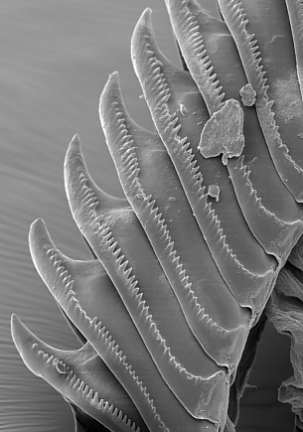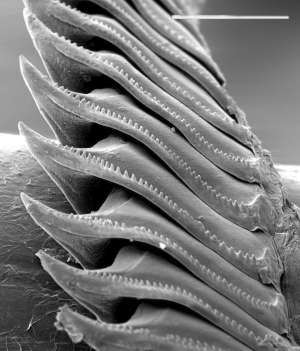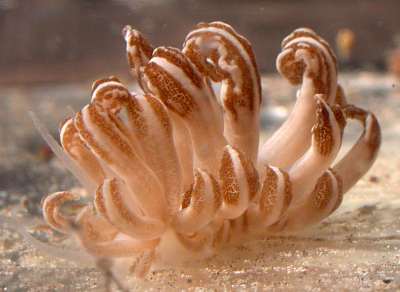
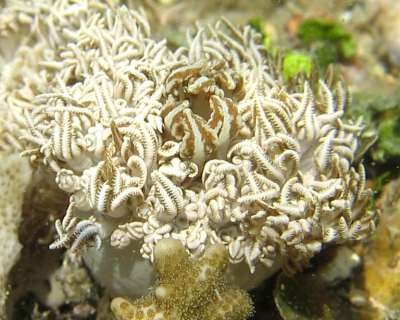
Phyllodesmium jakobsenae
Burghardt & Wagele, 2004
Order: NUDIBRANCHIA
Suborder: AEOLIDINA
Family: Glaucidae
DISTRIBUTION
Known from Indonesia & Philippines.
PHOTO
Bunaken Island, North Sulawesi, Indonesia. intertidal. Length: up to 30 mm. 12 July 2003. intertifal coral reef with patches of sea grass. Lower photo showing animal nestling in Xenia colony. Photographer: Michael Schrödl
Phyllodesmium jakobsenae is another species of Phyllodesmium which lives in, feeds on, and mimics the soft coral Xenia by the shape and colour of its cerata. It is solar-powered, retaining some of the soft corals zooxanthellae which continue to photosynthesise in the ceratal digestive gland cells. Probably the most characteristic external feature of this species is the shape of the cerata, which have a basal cylindrical, stalk-like, region which becomes broader and flatter toward the tip. In this upper region there is a central pale vein-like region flanked on each side by a broad brown flattened blade. On the upper, sunlit, side of the blade are spherical structures in which the zooxanthellae are 'farmed'. Of the Phyllodesmium which farm photosynthesising zooxanthellae, this is the only one we know that has no branching of the digestive gland in the body wall. It is reported to grow to 30 mm in length.
See illustrations of jaw and radula [#14684] and ceratal structure [#14681 ]
-
Burghardt, I. and Wägele, H. (2004) A new solar powered species of the genus Phyllodesmium Ehrenberg, 1831 (Mollusca: Nudibranchia: Aeolidoidea) from Indonesia with analysis of its photosynthetic activity and notes on biology. Zootaxa, 596: 1-18.
Rudman, W.B., 2005 (September 1) Phyllodesmium jakobsenae Burghardt & Wagele, 2004 . [In] Sea Slug Forum. Australian Museum, Sydney. Available from http://www.seaslugforum.net/find/phyllodjako
Related messages
Phyllodesmium jakobsenae - a new species from Indonesia
September 1, 2005
From: Ingo Burghardt
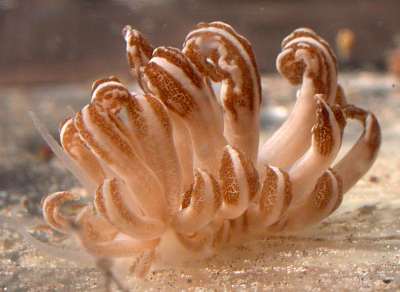
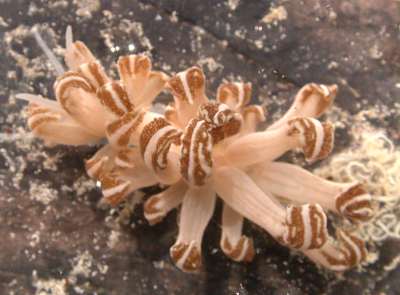
Dear Bill,
I would like to provide the Forum some pictures and info about the new Phyllodesmium species that Heike Wägele and I described last year.
Phyllodesmium jakobsenae is a "solar-powered " species and is very cryptic. It lives in Xenia soft corals and its cerata mimic the polyps of Xenia. P. jakobsenae feeds on the soft coral and retains some of the corals' zooxanthellae photosynthetic active inside their digestive glandular cells (for further details see our publication). We only found them close to Bunaken Island/ Sulawesi, but I've heard that some people also found them in the Philippines, so it might have a wider distribution.
Locality: Bunaken Island, North Sulawesi, Indonesia. intertidal. Length: up to 30 mm. 12 July 2003. intertifdal coral reef with patches of sea grass. Photographer: Michael Schrödl
-
Burghardt, I. and Wägele, H. (2004) A new solar powered species of the genus Phyllodesmium Ehrenberg, 1831 (Mollusca: Nudibranchia: Aeolidoidea) from Indonesia with analysis of its photosynthetic activity and notes on biology. Zootaxa, 596: 1-18.
Cheers,
Ingo
ingo.burghardt@rub.de
Burghardt, I., 2005 (Sep 1) Phyllodesmium jakobsenae - a new species from Indonesia. [Message in] Sea Slug Forum. Australian Museum, Sydney. Available from http://www.seaslugforum.net/find/13424
Dear Ingo,
Sorry it has taken me a while to post this message. It is indeed a spectacular Xenia mimic, perhaps not quite as good as Phyllodesmium sp. 11, but almost.
Best wishes,
Bill Rudman
Phyllodesmium jakobsenae from Philippines
September 1, 2005
From: Jeff Rosenfeld
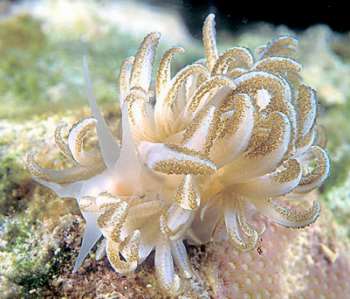
Hi Bill,
Here's a shot of Phyllodesmium jakobsenae taken in Anilao, Luzon Island, Philippines in April, 2004. I noticed you don't yet have a page for this species.
Locality: Anilao, Luzon Island, Philippines. Depth: 30 ft. Length: 20 mm. April, 2004. Photographer: Jeff Rosenfeld
Thanks,
Jeff
http://www.vibrantsea.net
jeff@rosenfeldfamily.net
Rosenfeld, Jeff, 2005 (Sep 1) Phyllodesmium jakobsenae from Philippines. [Message in] Sea Slug Forum. Australian Museum, Sydney. Available from http://www.seaslugforum.net/find/14661Dear Jeff,
Your message has made me drop everything and prepare a page for this species. Ingo Burghardt kindly sent a message [#13424 ] some months ago but I am afraid I am finding it increasingly difficult to keep up with the volume of material landing on my desk. At least now I won't feel guilty every time I see mention of this fascinating animal
Best wishes,
Bill Rudman
Phyllodesmium jakobsenae - ceratal shape
September 1, 2005
From: Bill Rudman
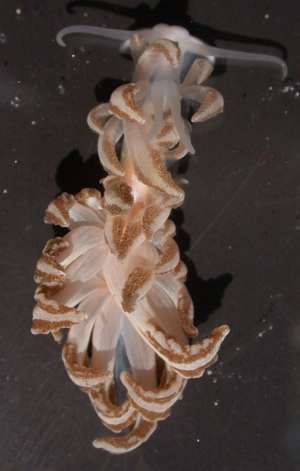
To accompany Ingo Burghardt's message [#13424] concerning Phyllodesmium jakobsenae here are some close-ups from Michael Schrödl's photos to show in more detail the shape and structure of the cerata. Ingo has mentioned the zooxanthellae symbiosis this species has, like many of its genus and the cerata have evolved to undertake the joint function of camouflaging the animal by making it look like part of the Xenia colony, and to provide a 'farm' where the sumbiotic zooxanthellae can live and photosynthesise. The brown patches on each side of the cerata certainly create the illusion of a thin pale tentacle Xenia tentacle. And amazingly the brown patches are in fact the zooxanthellae 'gardens'. In close-up we can see that in each patch there are dark brown spheres which I assume are the sacs packed full of zooxanthellae much like the sacs in the tentacles of Xenia that I have illustrated in the zooxanthellae in cnidarians Fact Sheet.
To quote from Burghardt & Wägele, (2004) " In P. jakobsenae the branching of the digestive gland shows unique features for the
Xenia-feeding Phyllodesmium species: The fine ducts terminate in sac-like structures and these are mainly concentrated on the flattened side of the ceras orientated towards the light."
Locality: Bunaken Island, North Sulawesi, Indonesia. intertidal. Length: up to 30 mm. 12 July 2003. intertifdal coral reef with patches of sea grass. Photographer: Michael Schrödl
-
Burghardt, I. and Wägele, H. (2004) A new solar powered species of the genus Phyllodesmium Ehrenberg, 1831 (Mollusca: Nudibranchia: Aeolidoidea) from Indonesia with analysis of its photosynthetic activity and notes on biology. Zootaxa, 596: 1-18.
Cheers,
Bill Rudman
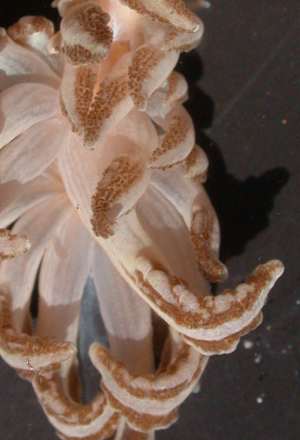
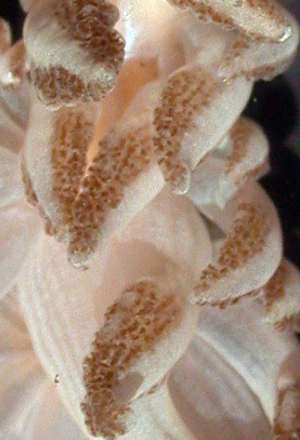
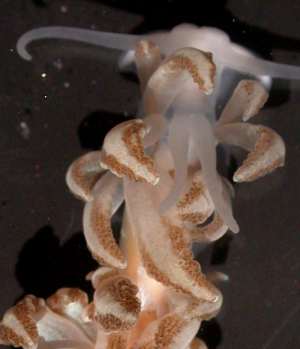
This photo shows the smooth rhinophores, long tentacular oral tentacles and pointed recurved anterior foot corners.
Bill Rudman
Phyllodesmium jakobsenae - radula and jaw morphology
September 1, 2005
From: Ingo Burghardt
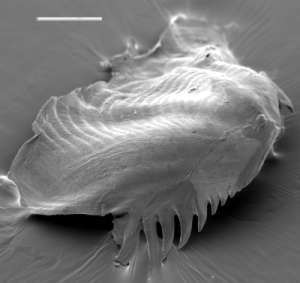
To accompany my message [#13424] on Phyllodesmium jakobsenae here are some scanning electron micrographs of the radular teeth and jaw plates.
Upper right: Jaw plate. Scale bar = 400 µm. Lower right: Radular teeth. Scale bar = 100 µm.
-
Burghardt, I. and Wägele, H. (2004) A new solar powered species of the genus Phyllodesmium Ehrenberg, 1831 (Mollusca: Nudibranchia: Aeolidoidea) from Indonesia with analysis of its photosynthetic activity and notes on biology. Zootaxa, 596: 1-18.
Ingo Burghardt
ingo.burghardt@rub.de
